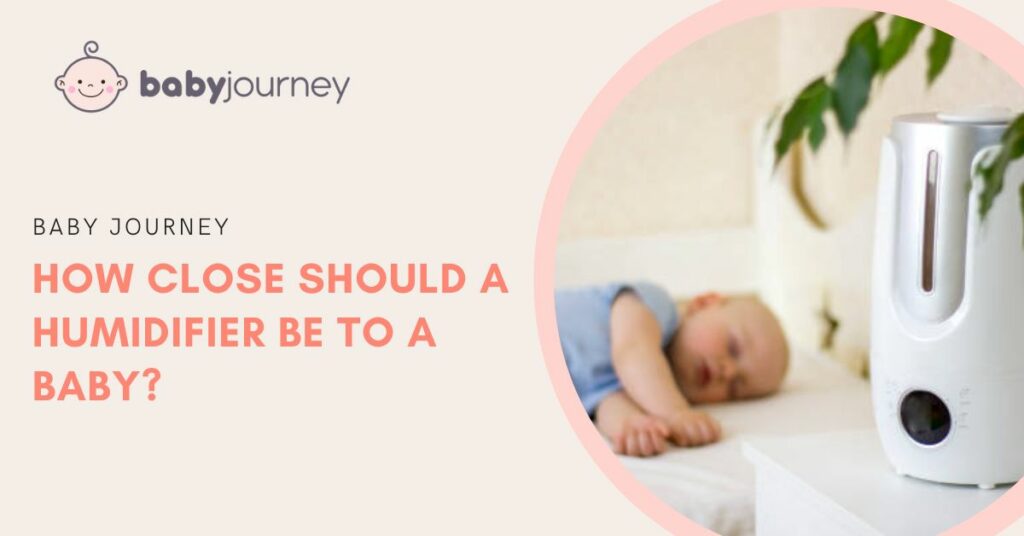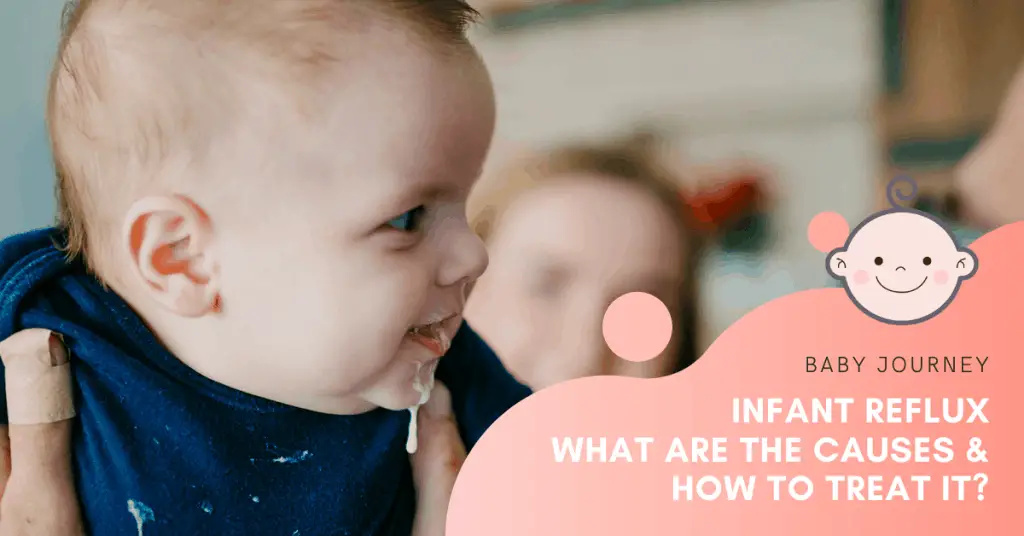How close should humidifier be to baby? When it comes to a baby’s room, parents want to ensure that everything is set up perfectly for their little one. One item that parents may consider adding to their baby’s room is a humidifier. Humidifiers can help alleviate dry skin and congestion in babies, but it’s important to know how close the humidifier should be to the baby.
According to experts, a humidifier should be placed at least three feet away from a baby’s bed or crib. This distance allows the mist to disperse easily in the area that needs to be humidified without causing moisture to accumulate on surfaces. It’s also recommended to position the humidifier at least two feet from the ground with a water-resistant tray below it to prevent any accidents.
However, the exact placement of the humidifier may depend on various factors, such as the layout of the room and the baby’s behavior. For example, if the baby is very active and curious, it may be best to place the humidifier in your baby’s side further away from their bed or crib to avoid any accidents. By understanding how to safely use a humidifier in a baby’s room, parents can help their little one breathe easier and sleep better.
- Understanding Humidifiers
- The Importance of Humidity for Babies
- Choosing the Right Humidifier for Your Baby
- Safety Considerations When Using a Humidifier
- Optimal Placement of Humidifiers
- Maintaining Your Humidifier
- The Role of Humidifiers in Nurseries
- Expert Opinions on Humidifier Use
- Conclusion
- Frequently Asked Questions
- What is the recommended distance between a humidifier and a baby?
- How long should a humidifier be on in a baby's room?
- Can a humidifier be too close to a baby?
- What are the benefits of using a humidifier for a baby?
- Are there any risks to using a humidifier in a baby's room?
- What are some features to look for when choosing a humidifier for a baby?
Understanding Humidifiers
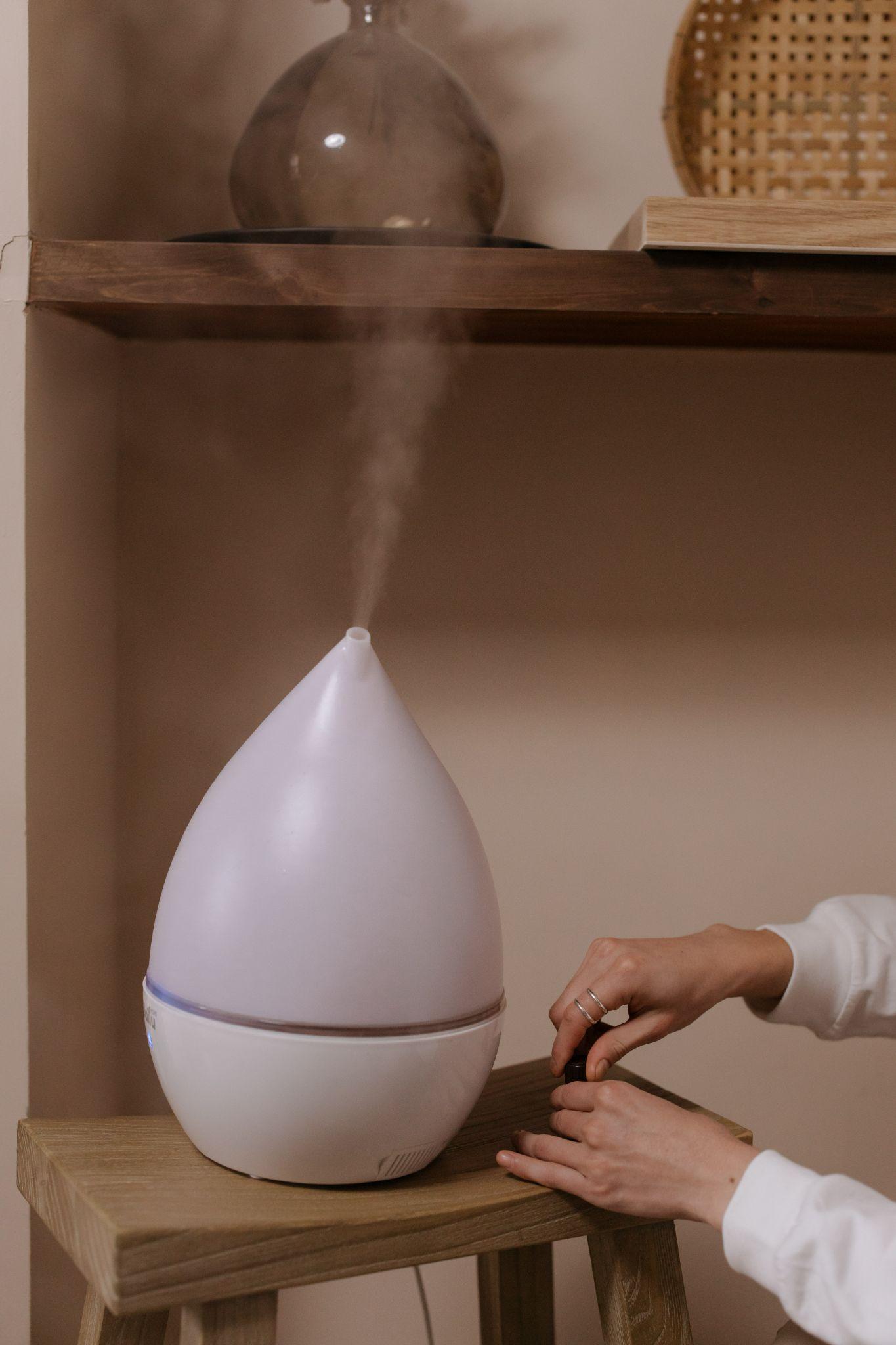
Humidifiers are devices that add moisture to the air, making breathing more comfortable. They are especially beneficial in arid locations or during the winter, when indoor heating systems can dry up the air. Humidifiers are classified as cool mist, warm mist, ultrasonic, and evaporative cool mist humidifiers.
Cool mist humidifiers use a fan to blow air through a wick or filter that has been soaked in water. The air picks up moisture from the filter and is then blown out into the baby room. Warm mist humidifiers, on the other hand, heat the water to produce steam that is released into the air.
Ultrasonic humidifiers generate a thin mist in the air by using high-frequency vibrations. They are often quieter than other types of humidifiers and can be more energy-efficient. Evaporative cool mist humidifiers function by forcing air through a wet wick or filter, which evaporates and adds moisture to the air.
When it comes to humidifiers for babies, it is important to choose the right type and to use them safely. Cool mist humidifiers are generally recommended for use around babies and young children because they do not produce hot steam that could be a burn risk. Vaporizers, which produce steam, are not recommended for use around babies because they can create hot spots that could burn a child.
It is also important to place the humidifier at a safe distance from the baby’s crib or bed. Experts recommend placing the humidifier at least three to four feet away from the baby to avoid any potential hazards. Additionally, the cord should be kept away from the baby’s reach to avoid any accidents.
Overall, humidifiers can be a useful tool for keeping indoor air comfortable and healthy, particularly for babies and young children. However, it is important to choose the right type of humidifier, use it safely, and maintain it properly to ensure it continues to function effectively.
The Importance of Humidity for Babies
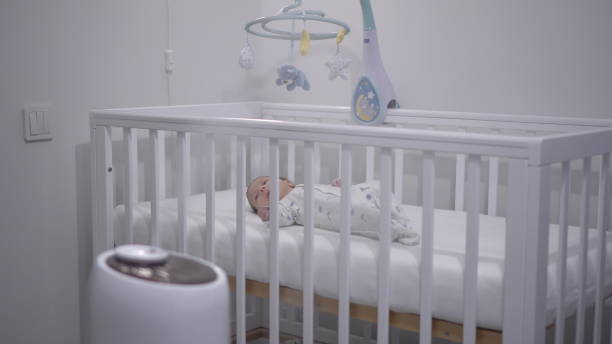
Humidity is an essential factor that plays a crucial role in maintaining the health and well-being of babies. The ideal humidity level for a baby’s room is between 40% to 60%. When the humidity level drops below this range, it can cause dry skin, nasal passages, and congestion, which can lead to breathing difficulties and other health issues.
Dry air can cause skin irritation, eczema, and other skin conditions in babies. Moisture in the air helps to keep the skin hydrated, soft, and supple. It also helps to prevent skin dryness and irritation, which can be uncomfortable for babies.
Moreover, dry air can cause respiratory problems in babies, especially those with pre-existing respiratory conditions. Dry air can cause mucus to thicken, making it difficult for babies to breathe. It can also cause nasal congestion, which can lead to upper respiratory infections.
Using a humidifier in a baby’s room can help to maintain the ideal humidity level and prevent these health issues. However, it is important to place the humidifier at a safe distance from the baby’s sleeping place to avoid excessive exposure to direct water mist or vapor exposure.
In conclusion, maintaining the right humidity level in a baby’s room is crucial for their health and well-being. A humidifier can be an effective tool to prevent dry skin, nasal passages, and congestion, which can lead to breathing problems and other health issues.
Choosing the Right Humidifier for Your Baby
There are several factors to consider while selecting the best humidifier for your infant. To begin, you must select between a cool mist and a warm mist humidifier. Both ways can add moisture to the air, but each has benefits and drawbacks.
Cool mist humidifiers are frequently advised for use in a baby’s room since they do not emit hot water or steam, which can be dangerous. They are also more silent than warm mist humidifiers. Warm mist humidifiers, on the other hand, can be useful for relieving coughs and congestion, as well as warming up a chilly environment.
Once you’ve decided on the type of humidifier you want, you’ll need to choose a specific model. There are several types of humidifiers available, including ultrasonic humidifiers and evaporative cool mist humidifiers. Ultrasonic humidifiers use high-frequency vibrations to create a fine mist, while evaporative cool mist humidifiers use a fan to blow air through a wet wick or filter.
When choosing a humidifier for your baby, it’s important to look for one that is specifically designed for use in a baby’s room. These humidifiers often have features like automatic shut-off and adjustable mist settings, and they may also be quieter than other models.
Another option to consider is a vaporizer, which uses heat to create steam that can add moisture to the air. However, it’s important to note that vaporizers can be a safety hazard and should be used with caution.
Overall, choosing the right humidifier for your baby is an important decision. By considering the type of humidifier, specific model, and safety features, you can help ensure that your baby’s room is comfortable and healthy.
Safety Considerations When Using a Humidifier
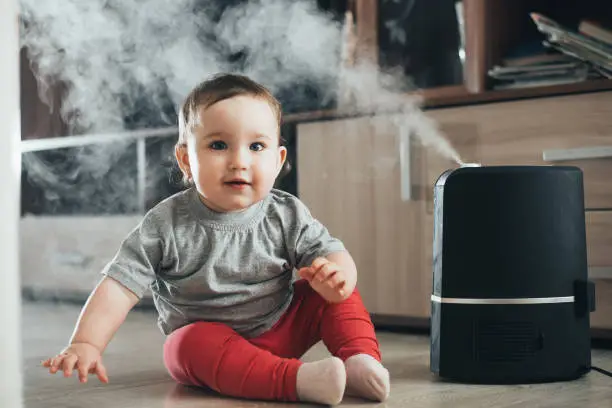
When using a humidifier in a baby’s room, safety should always be a top priority. Here are some important humidifier safety tips and considerations to keep in mind:
Distance and Placement
The humidifier should be placed at least three feet away from the baby’s bed to avoid too high a moisture level. It should also be placed out of the baby’s reach at least two feet high to prevent accidental spills. The humidifier should never be placed on a table or furniture where it could be knocked over by a curious baby. Additionally, it should not be placed in direct sunlight or near an electrical outlet.
Water and Vapor
It is important to use distilled water in the humidifier to prevent the buildup of bacteria and minerals. Tap water can contain minerals that can be harmful when inhaled. The humidifier should also be cleaned regularly to prevent the growth of bacteria and mold. When using a steam vaporizer, it is important to keep the vapor away from the baby’s face to avoid burns.
Safety Precautions
It is important to follow safety guidelines when using a humidifier for babies. The humidifier should have a water-resistant tray to prevent spills and leaks. It should also have an automatic shut-off feature that turns the humidifier off when the water level is too low. The cord should be kept out of the baby’s reach to prevent strangulation.
Moisture Levels
It is important to monitor the moisture levels in the baby’s room when using a humidifier. Too much moisture can lead to mold growth and other health issues. A hygrometer can be used to monitor the moisture levels in the room.
Allergies
If the baby has allergies, it is important to use a humidifier with a filter to remove allergens from the air. It is also important to clean the humidifier regularly to prevent the growth of mold and other allergens.
In conclusion, using a humidifier in a baby’s room can provide many benefits, but it is important to follow safety guidelines to prevent accidents and health issues. By keeping the humidifier at a baby safe distance, using distilled water, following safety precautions, monitoring moisture levels, and addressing allergies, parents can safely use a humidifier to alleviate dry skin and congestion in babies.
Optimal Placement of Humidifiers
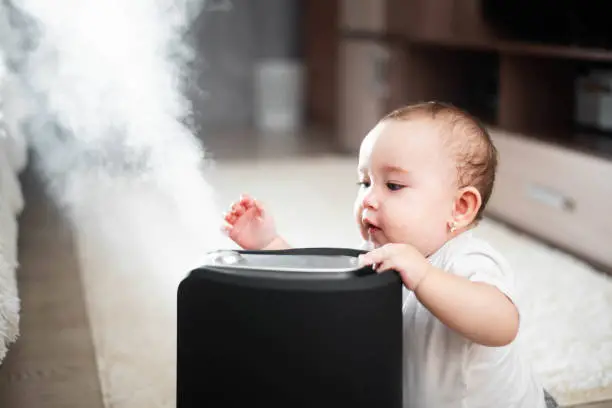
When it comes to placing a humidifier in a baby room, there are a few things to keep in mind to ensure optimal placement. Here are some factors to consider:
Distance from Baby
The humidifier should be placed at least three feet away from the baby’s sleeping area. This will ensure that the baby is not in direct contact with the mist and prevent any potential harm. Additionally, keeping the humidifier at a safe distance will ensure that the baby’s sleeping area is not too damp.
Reach of the Baby
It is important to keep the used humidifier clean and out of reach of the baby. Babies are naturally curious, and they may try to touch or play with the humidifier. This could lead to potential accidents or damage to the humidifier. Placing the humidifier on a table or a piece of furniture that is out of reach of the baby is recommended.
Cord Management
It is important to keep the cord of the humidifier out of the baby’s reach. A dangling cord could be a potential hazard for the baby. Additionally, keeping the cord out of the way will ensure that the baby does not accidentally unplug the humidifier.
Vapor Dispersion
The humidifier should be situated in an area where the mist may readily distribute in the area you wish to humidify without gathering on surfaces. This will keep the baby’s room evenly humidified. It is best to place the humidifier in the center of the room.
Outlet Accessibility
The humidifier should be placed near an outlet for easy access to power. Additionally, it is important to ensure that the humidifier is not placed too close to the outlet, as this could lead to potential hazards.
Overall, by keeping these factors in mind, parents can ensure that the humidifier is optimally placed for their baby’s safety and comfort.
Maintaining Your Humidifier
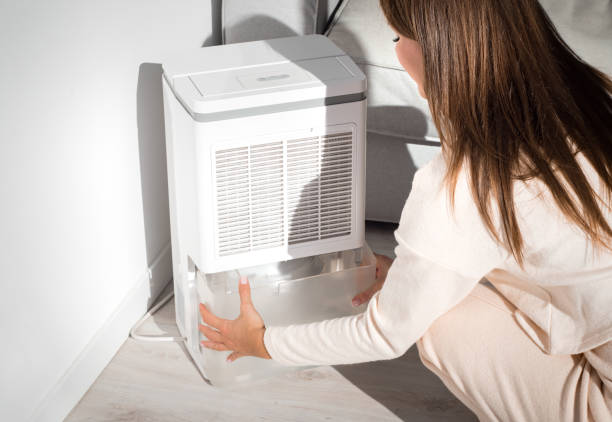
To ensure that air quality from your humidifier is safe for your baby, it is essential to maintain it properly. Here are some tips to keep your humidifier in good condition:
- Clean the humidifier regularly: Bacteria, mold, and germs can build up in your humidifier over time, which can cause health problems for your baby. Therefore, it is crucial to clean your humidifier regularly. Follow the manufacturer’s instructions for cleaning the unit, and use distilled water to prevent mineral buildup.
- Change the water daily: Stagnant water can harbor micro-organisms, so it is essential to change the water in your humidifier daily. Empty the water tank and refill it with fresh distilled water.
- Replace the filter: If your humidifier has a filter, it is essential to replace it regularly. The filter can become a breeding ground for bacteria and mold, which can be harmful to your baby’s health.
- Store the humidifier properly: When you are not using your humidifier, it is essential to store it properly. Empty the water tank and let it dry completely before storing it. Store the unit in a dry, cool place to prevent mold growth.
By following these maintenance tips, you can ensure that your humidifier is safe for your baby. Remember to clean your humidifier regularly, change the water daily, replace the filter, and store the unit properly.
The Role of Humidifiers in Nurseries
Humidifiers play an important role in maintaining the moisture levels in a baby’s nursery. In dry regions or during winter months when the air is dry, a humidifier can help add moisture to the air, providing a more comfortable and healthier environment for the baby to sleep in.
Dry air can cause discomfort, such as dry skin, nasal congestion, and irritation in the throat, making it difficult for babies to sleep. By adding moisture to the air, a humidifier can help soothe these symptoms and promote better sleep for the baby.
In addition to promoting better sleep, a humidifier can also help reduce the spread of viruses in the nursery. Viruses thrive in dry environments, and by adding moisture to the air, a humidifier can help reduce the risk of infections.
When using a humidifier in a nursery, it is important to keep it at a safe distance from the baby. As per experts, a humidifier should be placed at least three feet away from the baby’s crib, but no farther than five feet. This distance ensures that the mist doesn’t fall on the bed or the infant, preventing further complications.
Overall, a humidifier can be a valuable addition to a baby’s nursery, providing a more comfortable and healthier environment for the baby to sleep in.
Expert Opinions on Humidifier Use
Experts recommend using a humidifier to add moisture to the air and prevent dry skin, coughs, and congestion in babies. However, it is important to use a humidifier safely and correctly to avoid any potential hazards.
According to Jennifer Foersterling, MD, a pediatrician at the University of Utah Health, parents should keep the humidifier at least three to four feet away from the baby’s crib. Placing the device too close can cause skin irritation and increase the risk of burns. Dr. Foersterling also recommends using a cool-mist humidifier instead of a warm-mist one, as the latter can cause burns if the baby gets too close to it.
Another expert, Dany Paul Baby, MD, suggests that parents should clean the humidifier regularly to prevent the growth of mold and bacteria. Dr. Baby also advises against using essential oils in the humidifier, as they can be harmful to babies if ingested or inhaled.
In addition, Amber Dixon, a parenting expert, recommends monitoring the humidity levels in the baby’s room using a hygrometer. The ideal humidity level for a baby’s room is between 40% and 60%. If the humidity level is too high, it can promote the growth of mold and mildew. If it is too low, it can cause dry skin and respiratory problems.
Overall, experts agree that using a humidifier can be beneficial for babies, but it is important to use it safely and correctly. Parents should follow the manufacturer’s instructions, keep the device clean, and monitor the humidity levels in the baby’s room to ensure a safe and comfortable environment for their little one.
Conclusion
In conclusion, it is important to place a humidifier at a safe distance from a baby’s crib to avoid any potential harm. Research suggests that a distance of at least 3-4 feet away from the child’s reach is optimal.
It is also important to consider the layout of the room and the behavior of the baby when deciding on the placement of the humidifier. Placing the device in the center of the room can help the mist diffuse throughout the room more effectively. Additionally, the humidifier should not be pointed directly at the crib or bed to prevent excessive humidity in any one spot.
Parents should also be mindful of the type of humidifier they are using. Cool-mist humidifiers are typically seen to be safer than warm-mist humidifiers for usage around babies. Cool-mist humidifiers do not produce hot steam, which can burn newborns.
Lastly, parents should regularly clean and maintain their humidifiers to prevent the growth of bacteria and mold. Following the manufacturer’s instructions for cleaning and replacing filters can help ensure the humidifier is working properly and safely for the baby.
Overall, with proper placement and maintenance, a humidifier can be a helpful tool for parents in alleviating dry skin and congestion in babies.
Frequently Asked Questions
What is the recommended distance between a humidifier and a baby?
According to experts, the humidifier should be placed at least 3-4 feet away from the baby. This distance helps to prevent the baby from getting too close to the humidifier and reduces the risk of accidental burns or electrical shocks.
How long should a humidifier be on in a baby’s room?
The recommended duration for a humidifier to be on in a baby’s room is between 8-10 hours. This period is enough to maintain the optimal level of humidity in the room without causing any harm to the baby.
Can a humidifier be too close to a baby?
Yes, a humidifier can be too close to a baby. When a humidifier is placed too close to a baby, it can cause burns, electrical shocks, and other accidents. It is important to keep the humidifier at a safe distance from the baby to prevent any harm.
What are the benefits of using a humidifier for a baby?
Using a humidifier in a baby’s room can help alleviate dry skin, congestion, and other respiratory problems. It can also prevent the baby from getting sick frequently and help them sleep better.
Are there any risks to using a humidifier in a baby’s room?
Yes, there are some risks associated with using a humidifier in a baby’s room. If the humidifier is not cleaned regularly, it can become a breeding ground for bacteria and mold, which can cause respiratory problems. Additionally, if the humidifier is placed too close to the baby, it can cause burns or electrical shocks.
What are some features to look for when choosing a humidifier for a baby?
When choosing a humidifier for a baby, it is important to look for features such as a cool mist option, programmable settings, and easy-to-clean design. It is also important to choose a humidifier with a very white noise and level that will not disturb the baby’s sleep.


